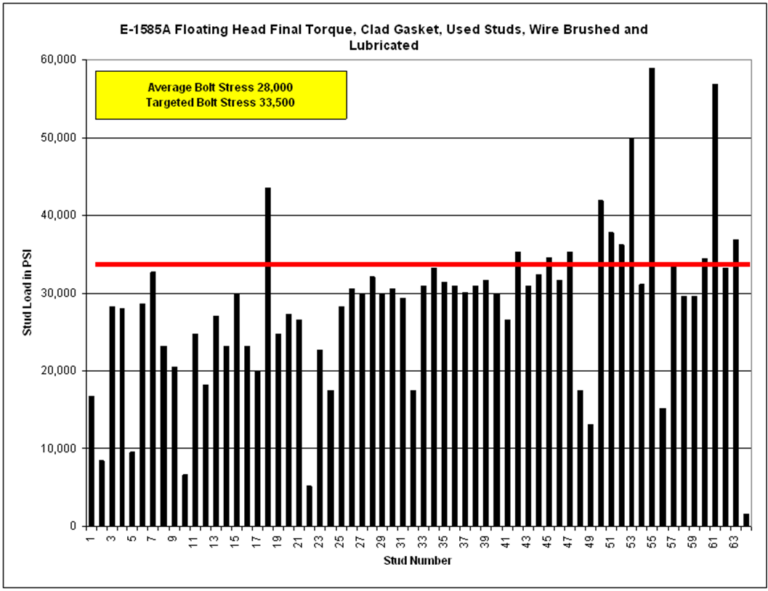As a matter of “best practices”, we recommend the use of new stud bolts whenever a heat exchanger joint is reassembled.
To a company that routinely cleans and reuses stud bolts, this recommendation to use new studs may seem a little bit over-the-top. Why should new studs be used when the used studs still look new? Isn’t that just a senseless waste of money? Why throw away a perfectly good stud? In this age of recycling, isn’t it better to reuse than to replace?
Remember the age-old idiom, “You can’t judge a book by its cover”? Well, here is a perfect example – you can’t judge a stud by its looks. It is true that pre-used stud bolts can be cleaned up. They can even be wire-brushed to look like new. But the appearance of a stud is not the most critical of its attributes. What is most important is its performance. And the data shows that the frictional drag on a used stud is very unpredictable.

Several years ago Chevron performed a field test to investigate this issue. Among the hundreds of heat exchangers in their El Segundo refinery are the “twin” heat exchangers, E-1585A and E-1585B, identical to each other in every regard. On the day of the test they replaced the floating head gasket on each exchanger and tightened the connection. Because there isn’t enough room on the floating head, no hardened washers were used. Other than that, best practices were used; they lubed everything properly and used a calibrated clicker torque wrench on both. The only difference between E-1585A and E-1585B was the condition of the studs. New studs and nuts were used on E-1585B. On the other, E-1585A, they reused the studs after they were cleaned and wire-brushed to “like new” condition. After torquing they measured the actual stud stress – and the results are what you see on the accompanying charts.
The first chart shows the results for the used studs used in E-1585A. The table included on the chart shows that the average stud stress was 28,000-psi, which was 16.4% off from the targeted stress of 33,500-psi. But the “average” stud stress doesn’t tell the whole story, as the scatter (the difference from bolt-to-bolt) is as much as 10-to-1! Even though the studs were well cleaned and well lubricated, it was impossible to predict just how much stud load would be generated at a specific torque.

The second chart shows a greatly improved picture. The average stud load is now only 12% off from the desired load. But more importantly, the scatter has been dramatically reduced – most of the stud loads are within 10% to 15% of the average, and the amount of disparity from the lowest to the highest has been reduced by 83%!
Remember that these results were achieved without the use of hardened washers under the rotating nut. It is very likely that the use of hardened washers to reduce the frictional drag at the flange face would have reduced the scatter even more, and would have boosted the average stud load closer to the projected load. However, even though these results are not “perfect”, they are certainly “reasonable”.
Why is this critical?
Chevron has proved through years of research that in addition to using an optimal gasket type, the secret to long-term sealing in heat exchangers depends on how one deals with relaxation in the joint. In order to manage relaxation it is critical to load the gasket to achieve a high seating stress. This needs to be done reliably to a high, predetermined value.
So if an engineer determines that a gasket needs 20,000-psi seating stress to give long-term reliability – and that 600 ft-lbs torque (for example) is required to achieve that load – he has to be able to depend on the fact that when the studs are torqued to 600 ft-lbs that they will actually generate the bolt stress he anticipates.[1]
And that is the problem with used studs. Due to the almost microscopic rolling and galling on the thread surfaces, the stud no longer converts torque into stress in a predictable manner. The relationship between bolt torque and gasket load is broken. Because of this, Chevron requires the use of new studs whenever an exchanger joint is opened.
Now there are a couple exceptions to this rule – and Chevron recognizes them in its standards. First, if a stud is being tensioned (not torqued), then it’s fine to reuse them – as torque doesn’t come into play. Second, if a person is willing to run the threads on both the studs and nuts with a tap and die – thus renewing the threads – they can safely reuse the fasteners.
The argument is sometimes advanced that used studs are better than new studs because they have been work-hardened. The simple response to that argument is that work-hardening doesn’t matter. What matters is the ability of the stud to deliver a predictable load to the gasket – because that is how leak-free performance achieved.
The proof of this approach is easily seen in Chevron’s experience. In the past decade they have achieved what many considered impossible – they have eliminated exchanger leaks from their refineries. Using new studs to optimize the gasket load is an important component of the solutions employed to achieve this end.
[1] For a more complete discussion on the importance of targeting specific gasket seating stresses rather than specific stud stress, see the Tech Note titled Stud Stress or Gasket Stress? Hitting the Right Target.